Coastal Heritage Magazine
Writing Toward Place: Inspiration From The World Around Us
South Carolina’s Nikky Finney writes toward place—incorporating environment, Black history, generational histories, social justice, and culture into her work.

IMAGINATION. Nikky Finney, poet and professor of creative writing at the University of South Carolina, takes inspiration from the world around her. Photo by Crush Rush.
Writing Toward Place
From the roiling, tangled histories of the Atlantic Ocean to the crinkling of newspaper wrapped fish in a fishmonger shop in Sumter to the rice fields of the humid Lowcountry, Nikky Finney keeps an eye on the details around her—past and present. Animal, mineral, vegetable.
“I’m so lucky that I’m so unabashedly curious and slightly stubborn about wanting to know everything I can know in this short life,” says Finney. “I’m a lifetime student of history, science, philosophy, botanicals, minerals, dinosaurs, pencils, orchids, amphibians, opals, blue beads, etcetera. You get the picture. I somehow avoided being trained out of my belief in interconnectivity. This is not a theory. This is the way I live.”
Born in 1957 in Conway, South Carolina, and raised in Sumter, Finney is a poet, the John H. Bennett, Jr. endowed professor of creative writing and Southern letters and a Carolina distinguished professor at the University of South Carolina, and the executive director of the Ernest A. Finney, Jr. Cultural Arts Center. She is the daughter of a lawyer. The daughter of a teacher. An advocate for social justice and cultural preservation. And a vital voice in South Carolina’s thriving arts community.
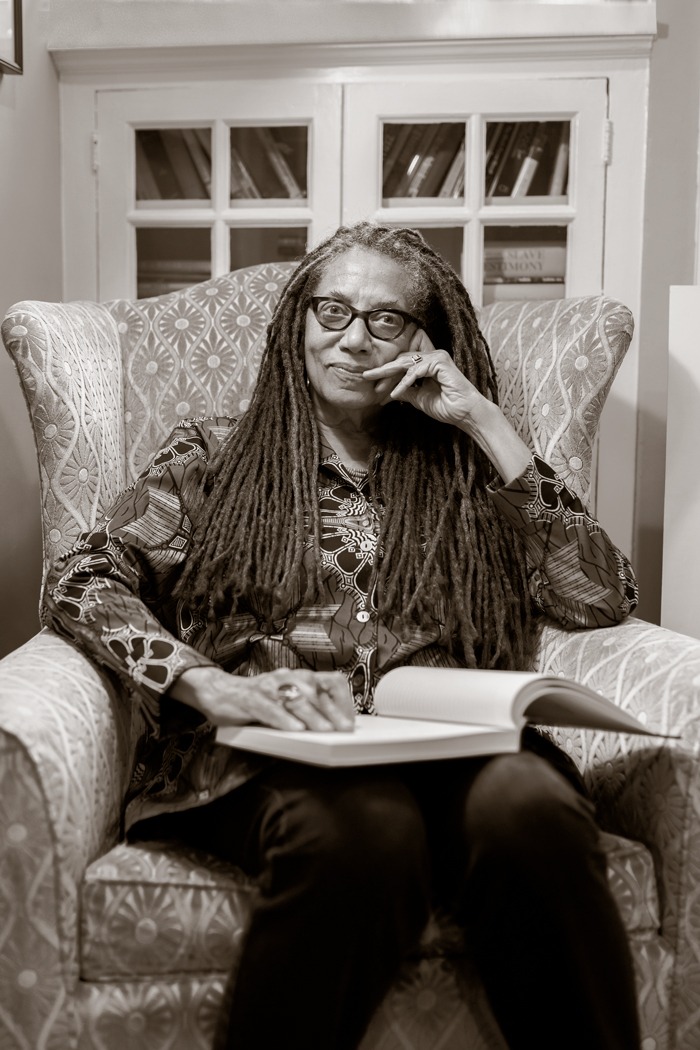
ON THE COVER: Nikky Finney at her home in Columbia, South Carolina. Photo by Crush Rush.
But above all, she is curious.
In tandem with innate curiosity, Finney looks toward memory to guide her writing. To begin writing, she often initiates composition with flashes of her own visual memory—a testament to her acute sense of observation and sensory processes (“smell, taste, sound, touch, and other”). When asked whether a specific memory informs her writing process, Finney mentions her birth, life by the sea, and reading Rachel Carson as moments she holds close.“I follow the first agitations as far as I can before turning that mental curiosity over to my imagination—which always wants to weigh in—and never be treated like anything secondary. Being born so close to the Atlantic Ocean gave me this particularly rich sensory board. Instead of going to the park as a family we went to the ocean to play, picnic, leave the world behind. I realized early in my life that the ocean—particularly the Atlantic—was the wellspring of everything I would ever write. This has proven to be true. Each time I return to the land (and water) of my birth there is a deep tingling, physically and emotionally. When I discovered Rachel Carson’s writings, in my Thirties, I remember walking the shore and staring side eye at the water and smiling and whispering to myself ‘Oh, this must be the spot where I finally ‘made land.’’ I totally understood the transformation from sea creature to land, from fins to feet,” says Finney.

OCEAN VIEWS. Ghost forests—formed as sea levels rise and saltwater moves inland—cast an eerie and enchanting silhouette on a beach at sunrise. Photo by Grace Beahm Alford.
She’s also keenly aware of the memory of her birth. As a newborn, she was diagnosed with jaundice and held in an incubator for eight days while her mother was discharged: “My imagination informs me that my birth was indeed the moment that I came ashore—through my mother. Rachel Carson taught me there was an incredible shift in the earth’s history when the sea animals came ashore. This was my moment. I will always feel that my lungs simply needed a little extra time to transition.”
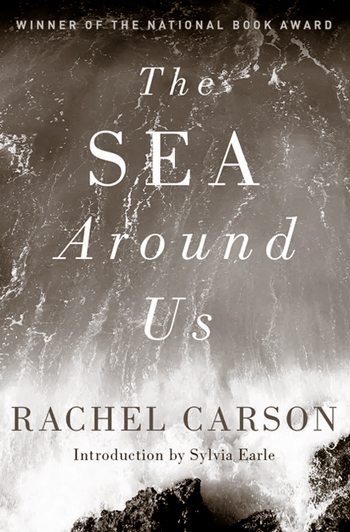 Rachel Carson (1907–1964)—the writer and environmentalist best known for the 1962 book, Silent Spring, and other works: The Sea Around Us, Under the Sea Wind, and The Edge of the Sea—wrote along perceived lines that straddled science and art, calling attention to the peril and beauty within the environment. Those lines between science and art were drawn fairly recent; fueled by misinterpretations of neurobiologist Roger Sperry’s work from the ’50s and ’60s.
Rachel Carson (1907–1964)—the writer and environmentalist best known for the 1962 book, Silent Spring, and other works: The Sea Around Us, Under the Sea Wind, and The Edge of the Sea—wrote along perceived lines that straddled science and art, calling attention to the peril and beauty within the environment. Those lines between science and art were drawn fairly recent; fueled by misinterpretations of neurobiologist Roger Sperry’s work from the ’50s and ’60s.
Sperry’s laboratory illuminated important discoveries in brain hemispheric specialization (he’d go on to share the 1981 Nobel Prize in physiology and medicine for this work). For example: the right hemisphere is responsible for musical or spatial tasks while the left for more verbal or analytical functions. As a result, a false dichotomy arose between the sciences and arts—the public misinterpreting Sperry’s split-brain theory to mean that people were either good at science and math or language and art. Although the idea that right-brained creativity persists today, there is little empirical data to support this conclusion.
Carson’s work sought to inform and connect readers to the world around us through literary leanings and scientific observations. Her body of work has proven to be a cultural lodestar for environmental writing through the intrinsic link between language and science, providing an example for those who would follow—calling attention to environmental concerns and fascinations.
“Like the sea itself, the shore fascinates us who return to it, the place of our dim ancestral beginnings,” wrote Carson in 1955, published only a couple years before Finney’s birth.
Lockstep with Carson’s literary endeavors and Finney’s Atlantic-based upbringing, Finney’s work also functions across similar links by tying her work to place. She does this by considering not only environmental observations, but also drawing our eyes toward generational histories, Black history, culture, South Carolina, and memory.
 “I don’t stop to ask, can I do all of this mixing and re-classification? I know that if I am asking good questions about things that matter to more than just me, I know that if I’m asking those questions for all the right reasons, then I will eventually arrive at some new stratosphere of understanding. I would prefer to not land at the airport where its safe and predictable. I would prefer to land in a rockier spot. A wilder untamed spot,” says Finney. “The circuitousness you speak of in my work might be there because of my relationship to the natural world. Humans are doing their best to mightily screw up that relationship right now but nature will march on no matter what humans refuse to do for humanity. I am guided by so many sounds that still exist in the forest. I am drawn to so many understandings that frogs and salamanders and abalone and spiny oysters have taught me about the color orange and lime green. So many humans associate colors with universities and athletic teams. I associate colors with mammals and rocks and reptiles. The first order.”
“I don’t stop to ask, can I do all of this mixing and re-classification? I know that if I am asking good questions about things that matter to more than just me, I know that if I’m asking those questions for all the right reasons, then I will eventually arrive at some new stratosphere of understanding. I would prefer to not land at the airport where its safe and predictable. I would prefer to land in a rockier spot. A wilder untamed spot,” says Finney. “The circuitousness you speak of in my work might be there because of my relationship to the natural world. Humans are doing their best to mightily screw up that relationship right now but nature will march on no matter what humans refuse to do for humanity. I am guided by so many sounds that still exist in the forest. I am drawn to so many understandings that frogs and salamanders and abalone and spiny oysters have taught me about the color orange and lime green. So many humans associate colors with universities and athletic teams. I associate colors with mammals and rocks and reptiles. The first order.”
Her work includes the collections Love Child’s Hotbed of Occasional Poetry, Rice, Heartwood and Head Off & Split (a 2011 National Book award winner), among others. In Rice, Finney considers the history of rice, culture, and the continent of her ancestors. In Head Off & Split, Finney takes inspiration from a fishmonger—Liberty Street Seafood in Sumter—she visited throughout her life. Throughout all her work, a pervasive sense of wonder and discerning eye for connection is readily apparent to readers.
“Black Pearl”—Atlantic Beach, South Carolina
And Finney’s future projects?
She’s taking on Atlantic Beach—or the “Black Pearl.” Located in Horry County, Atlantic Beach is one of the few beach towns in the United States predominately owned by African Americans. The town is made up of about four blocks located within a stretch of North Myrtle Beach. Its origins began in 1934 when George Tyson bought forty-seven acres of beachfront property followed by the acquisition of more adjoining land in the years to follow. The Atlantic Beach Company was then formed by a group of business people, doctors, educators, and community leaders to further develop Atlantic Beach for Black Americans in the ’40s and ’50s. In a segregated South, Atlantic Beach was a vibrant vacation destination, providing Black beachgoers and visitors one of the few havens and avenues to the Atlantic Ocean. Today, the communities and residents of Atlantic Beach continue to seek ways to revitalize the area while preserving its identity and history. Entering its forty-third year, the annual Black Pearl Cultural Heritage and Bike Festival draws thousands of visitors to the beach town on Memorial Day weekend.

SOUTH CAROLINA’S “BLACK PEARL”. Atlantic Beach is located in Horry County in an area within North Myrtle Beach. Map by Crystal Narayana/Google Maps.
“I’m working on a long story, in poetic form, about a place known as the Black Pearl. It was a small beach town where Black people could go and relax for a weekend or a few weeks in the summer and not be hounded by hatred and racism. The state of South Carolina actually put orange buoys and ropes out in the water in the 1940s to keep Black people on their side of the water and allow White people to swim in water that did not contain Black people. How ridiculous this is. Racism is ridiculous in so many manifestations,” Finney says. “The story I’m writing is fiction based in the arms of real history. One of the main characters is a young Black woman deep sea diver, an occupation I could not imagine when I was a girl growing up in South Carolina and another character is an older Black woman who has been a witness to a great deal of the Black Pearl’s history. Ugly and beautiful. That’s all I can say about it right now.
I don’t want it to run away from me before I get it all down.”
Linking Individuals to Community
Interconnectedness is an emblem of Finney’s work, pushing against the idea of insular experience as the center while speaking toward a larger shared experience of community and history.
When asked to speak to how the “individual” appears to share the same center point as “community” in her work, Finney offered: “The only understanding that is going to save us as a species and avoid a sixth massive extinction is the fact that we need each other. The poets and the artists are saying this at different levels but not too many other groups are leading this chant. We need each other in every way. But we are so myopic as different societies and so sadly attuned to only the face in the mirror. Selfies and screen shots that make us look like we are the first people to ever know anything. We are fooling ourselves into a horrific corner. We do not have the urgency or the understanding about our deep and historical and spiritual interconnectedness that we need to stop the extinction that is happening every minute of every day. We see the Rain Forest as Brazil’s problem. We see the oil rigs leaking in the Gulf of Mexico as Louisiana’s problem.”
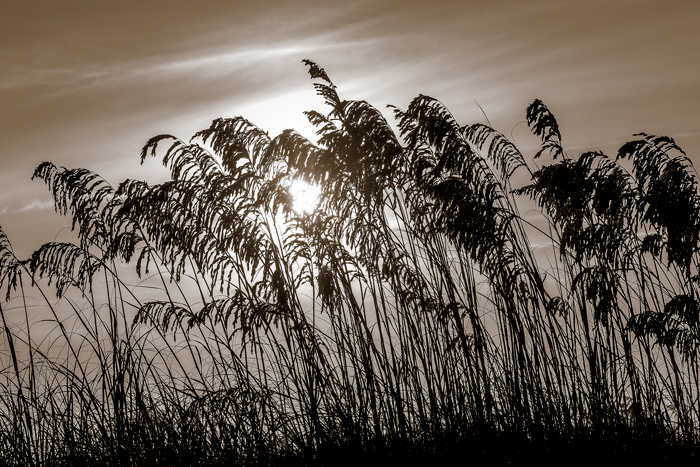
COMMUNITY. Sea oats—important plants for dune stabilization are protected by law—flourish in dunes along Horry and Georgetown County. Photo by Grace Beahm Alford.
Finney continues alongside the writing of others in thinking of community and the environment—the likes of Aldo Leopold, Ishimure Michiko, and J. Drew Lanham stand in concert, echoing ideas of interconnectedness.
Aldo Leopold (1887–1948)—an American writer and conservationist known for his 1949 work, A Sand County Almanac and the philosophical framework of the land ethic—stated to “care for the land is care for the people.”
While Ishimure Michiko (1927–2018)—a Japanese writer and activist known for writing on the Minamata disease, a neurological disorder caused by methylmercury poisoning—shed light on how industrial pollution affected communities and aquaculture through the link between health and the environment. Minamata disease was also called “dancing cat fever” due to the noted neurological effects in coastal domestic cats that consumed seafood in the area.
Carson’s work in Silent Spring brought similar attention to the effects of widespread use of pesticides like dichlorodiphenyltrichloroethane (DDT) in the United States. Her work would prove to be a fountainhead for further conversations in the U.S.—eventually, the Environmental Protection Agency would form in 1970 and DDT would be banned in 1972.
Another South Carolina writer, J. Drew Lanham—writer and ornithologist known for The Home Place: Memoirs of a Colored Man’s Love Affair with Nature—believes in the interconnection in his conservation ethos of “the head and the heart connection.” Lanham marries scientific facts with an individual’s emotional connection with nature as a way to encourage conservation. In doing so, Lanham also stresses a foundation in understanding the historical and cultural ties people have with the environment.
Writers and their histories of community examine the cultural lenses from which the environment is inextricably linked, shedding light on concerns as well as fascinations we share.
“We are human beings. When we are connected to each other and to the rest of the world—and not just the part that has our name on it—we can do anything we set our hearts to,” says Finney.

AT HOME IN SOUTH CAROLINA. Finney was born near the Atlantic Ocean in Conway, but is now based in Columbia. Photo by Crush Rush.
Ernest A. Finney, Jr. Cultural Arts Center
In another avenue of community, Finney also bears the mantle of executive director of the Ernest A. Finney, Jr. Cultural Arts Center. The cultural arts center opened its doors to the public in the summer of 2022.
The center, located in Columbia in the Robert Mills district, aims to bring together the celebration of art, community, and Black history. It is a bustling space built from the foundations of the shuttered Southern Electric building. It begets its name from Finney’s father, Ernest A. Finney, Jr., a prominent figure in South Carolina history. Ernest A. Finney, Jr.—also known as the “Black Fox” for his ability to bring people together despite discomfort of topic—was the first African American Supreme Court Justice appointed to the South Carolina Supreme Court since the Reconstruction Era and an influential figure in the civil rights movements in the ’60s and ’70s.
On the new cultural arts center, Finney envisions the space and what it might mean: “We are building a new community institution. It is focused on the richness of the Black Cultural Arts. We believe when you keep the arts at the forefront of your decision making you are moving in the right human, geographical, and spiritual directions. We do not believe the arts are what you engage with only on the weekend. We hope to be an incubator of ideas focused on how the making of music, dance, poetry, film, painting, and more can make us more aware human beings and better side-by-side communities,” Finney says.
The Ernest A. Finney, Jr. Cultural Arts Center has already hosted visual artists, musicians, workshops, artists’ markets, and community conversations—with a growing roster of future events hallmarking a bedrock of cultural incubation.
Jason L. Rapp communications director of the South Carolina Arts Commission says, “Cultural arts centers are important to their communities because they understand the context of a place. Being rooted in a community gives them the ability to help it tell its story or stories through tailored programming. It is a ground-up approach as opposed to a movie theater. Those too are artistic experiences, but the content is from somewhere else featuring someone else. Cultural art centers so often feature their community’s talent.”
And Finney plans to do just that: “One of our structures at the new Cultural Center is called the Longhouse. It is one 6000 square foot room where we hope to bring our differences and hold, embrace, tell stories, teach, read together, inform, inspire, re-direct, and embolden each other in every human way possible.”
Writing Toward Genius Loci
Consider genius loci—the spirit of place.
Genius loci in Roman religion referred to an intangible protective spirit of a specific place. The term often held religious or mythical connotations. In Eastern cultures, a similar “spirit of place” occupied the environment. In Japan, kami were spirits that inhabited natural elements in the landscape (waterfalls, rocks, trees, and sea) and guided early inhabitants.
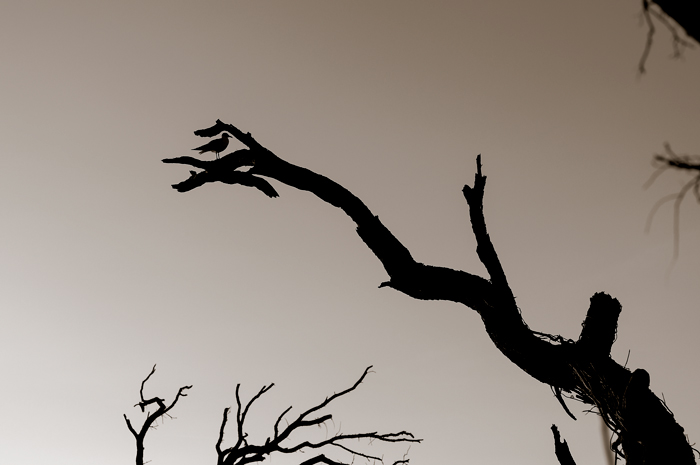
GENIUS LOCI. A gull’s striking profile among twisted branches greets visitors at dawn. Photo by Grace Beahm Alford.
Contemporary uses of genius loci now refer to the atmosphere or character of place; the term embodies not only the environment, but the culture, society, and history of a specific place.
Writers such as Nikky Finney and J. Drew Lanham in South Carolina, to writers like Rachel Carson and Aldo Leopold document genius loci, capturing the interactions between culture and environment.
To locate South Carolina’s genius loci, writers such as Finney find interconnections between science and art. Between past and present. Circumnavigating negative histories is avoided; instead, they’re tackled headfirst. There is less of a fixation on the purely pastoral, a feature of early nature writing in the eighteenth century. Writing seeks to connect the past and present, examining experience. History and poetics. Preserving a spirit of place, between the fishmonger and the Atlantic Ocean and the poet in Columbia.
Or as Rachel Carson wrote: “The history of life on earth has been a history of interaction between living things and their surroundings.”
Charleston’s Poets Laureate
The aromatic, glabrous leaves of the bay laurel are a deep glossy green. Native to the Mediterranean, this illustrious evergreen—the bay laurel, Laurus nobilis—is more than an element of cuisine or medicinal application.
A humble plant, the laurel tree has a noble tie to classic mythology: Apollo, the god of sun, healing, poetic arts, and prophecy, among other things. Apollo’s laurel tree story is complicated—amounting to a dubious fixation or incited love of Daphne who would go on to turn into a bay tree to avoid him, according to some versions. The story culminates in Apollo claiming the bay tree sacred, anointing it in lore and cementing the tree’s symbolization of high esteem.
That esteem translated to laurel wreaths or crowns being bestowed on honorees as an emblem of victory and success. Arising in Ancient Greece, honoring poets (and heroes) is a long-lived tradition. Aristotle even wrote in Poetics in the fourth century BC that “poetry is finer and more philosophical than history; for poetry expresses the universal, and history only the particular.”
“Laureate” then comes from the Latin root word lareatus, loosely meaning “crowned with laurels.”
So how did we come to confer laurels to our poets?
The answer begins during the Renaissance when early honorific iterations of the poet laureate were recognized by monarchs or even cities. It wasn’t until 1616 in the United Kingdom when James I granted a pension to a writer that we would see a semblance of the version we have today. The first official poet laureate of the United Kingdom was appointed in 1668 by Charles II. The official title of “poet laureate” is now an honorary position that is bestowed by a government, city, state, or monarch. The purpose? A poet laureate’s aims are to broaden poetry’s accessibility, raise appreciation and awareness of reading, advocate for poetry, and embody the artistic integrity of the country (or place).
Echoing the United Kingdom’s custom, the United States created a “consultant in poetry to the Library of Congress” position in 1937 (originating from a 1936 position) that would be renamed “poet laureate consultant in poetry” in 1986. Selected by the Librarian of Congress, Ada Limón is the current poet laureate consultant in poetry, the twenty-fourth in the nation’s history. The poet laureate of the United States may give lectures and readings while taking on a poetry project—the duties of the position are dictated by each poet laureate’s priorities.
As a part of NASA’s “Message in a Bottle” campaign, Limón’s poem, “In Praise of Mystery: A Poem for Europe,” will be engraved on the Europa Clipper spacecraft. Individuals are encouraged to sign their name to the poem to be etched onto a microchip and carried along the 1.8-billion-mile journey. The spacecraft is set to launch to Jupiter and its moons in 2024. While Europa Clipper’s mission is to gather information, the “Message in a Bottle” campaign hopes that its mission symbolizes inspiration and the desire to ask questions—and spark innovation. For Limón, this is but one facet of the position.
For South Carolina, the position was established earlier: since 1934, there has been a South Carolina poet laureate that is selected by the governor. Six since its inception. Marjory Heath Wentworth was the last South Carolina poet laureate, selected in 2003 by Mark Sanford and served until her resignation in 2020. The position has been vacant since.
The storied tradition would eventually find a home in Charleston in 2016. Marcus Amaker was named the inaugural poet laureate, holding the position for six years before stepping down.

MARCUS AMAKER. At a public reading, Charleston’s first poet laureate engages the audience at the Charleston Library Society. Photo by Grace Beahm Alford.
“When I became a poet laureate, I made a point to hold up a mirror to the city and write about everything I saw in its reflection. Everything is in there: the architecture, the history, the mimosas, the bike riders, the poverty, the wealth. Everything,” says Amaker about his work being in conversation with Charleston. “To love someone is to love their light and dark sides. In sickness and in health. I love Charleston; I am not afraid to look at its shadow side.”
A$iahMae was named the second poet laureate of Charleston after being selected from an open call for the position: “I’m not big on representation politics, but I do understand, now more than ever, how important it is for someone like me to have this role. I know that the way that I look, where I come from and how I decide to live my life representative of times changing, and I’m honored to be chosen to serve my community in this way.”
Charleston Mayor John Tecklenburg appointed both poets laureate and says, “Charleston is blessed with a thriving arts community that not only entertains, but challenges and inspires, and our poets laureate are no exception. We’re proud not just of Marcus and Asiah’s remarkable literary talents, but of their dedication to bringing people together through the power of their work and their commitment to using their words to inspire positive change in our community.”
What do poets bring to cities like Charleston?
A$iahMae, Charleston Poet Laureate 2023–Present
A$iahMae is a writer, producer, performing poet, and community organizer. Their hope is that Charleston will become known as an incubator for emerging artists, fostering diverse and inclusive talent: “I’d like to see Charleston embrace the weird and radical, and step into more of a leadership role in terms of artistic innovations.” There’s also the hope that poetry will be better understood and shake loose preconceived notions that poetry has a “right form” or an acceptable aesthetic. In August, A$iahMae will begin their incubator, an eight-week intensive on “the art of making a career as a poet.” The goal: equipping writers outside of academia with tools to build sustainable careers. The incubator will lead participants to a culminating performance at the city’s Free Verse Festival and inclusion in a printed anthology.
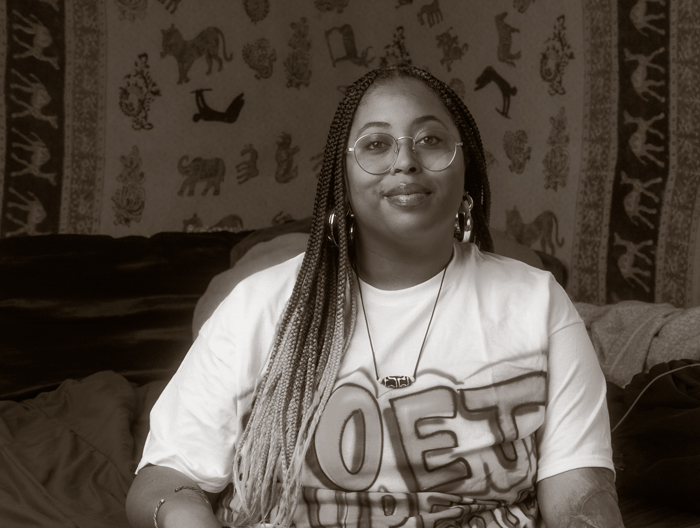
A$IAHMAE. Continuing the line of Charleston’s Poets Laureate, A$iahMae was appointed the city’s second laureate. Photo by Joshua Parks/Provided.
“Being the next poet laureate affords me the unique opportunity to be a voice for poets and artists like me in this city in spaces where we may not usually have access. It allows me to direct resources to spaces where they are most deserving, and gives areas of Charleston art that are severely underserved. I think for the city it aids in its growth, and I’m grateful for that,” says A$iahMae.
Marcus Amaker, Charleston Poet Laureate 2016–2022
Marcus Amaker is a poet, musician, teaching artist, and father. He is also an Academy of American Poets fellow and was named an artist-in-residence at the Charleston Gaillard Center. A prolific writer, Amaker has ten published books—the latest, Hold What Makes You Whole. And in April 2024, his original opera, The Weight of Light, with composer Gillian Rae Perry will premiere at the Chicago Opera Theater. During his term, Amaker launched the Free Verse Festival in Charleston, an event that showcases art and poetry’s importance to the city. He also frequents local schools, advocating for the arts. Through Poets in Schools, Amaker connects schools with poets to bring poetry workshops to new generations.
“I have the encouragement to speak from a place of truth,” says Amaker on being a poet laureate. “It’s also very important for students to know that being an artist is a viable profession. I’m through with the idea that being an artist automatically means being a ‘starving artist.’ It doesn’t. All of the poets I know are living abundant lives.”

ENGAGEMENT. Amaker reads from his book, Hold What Makes You Whole, to Charleston community members. Photo by Grace Beahm Alford.
Additional Benefits
According to a study commissioned by South Carolina Arts Commission, the arts help South Carolina grow—in tangible and intangible ways.
Based on 2021 data, 123,550 billion jobs were supported by the South Carolina arts-related cluster, which generates $5.7 billion in wages and salaries. Annually, an estimated $360.2 million in tax revenue is generated from the arts-related cluster while a total economic impact of $14.1 billion is also seen through direct and indirect demand (of spending of all arts-related businesses, suppliers, and employees).
“The arts are uniquely positioned in that they give glimpses of the past and, through creative, forward-thinking artists, hint at where we can go as a culture. That is important to who we are as a collection of people groups populating one state together. They tell stories in multiple dimensions, often those of previously marginalized voices now being heard. Economically, arts and creativity touch many more things than just books or paintings. Those things are part of it, but think about artisans who operate shops and the people who work at the places where they source materials. Think about fashion and interior designers or architects. Think about orchestra musicians or ballet dancers, and also the people who staff the places they perform and the hard workers who help you enjoy pre-show meals or post-show beverages,” says Rapp. “The arts support all of that and much more.”
From origins in Greek mythology to the heads of antiquity’s victors, to a journey to Jupiter and the halls of Charleston, the mythos of the laurel tree and a centuries-old tradition continue to evolve. But with one certainty for the future: the hope that we’ll refuse to rest on glistening laurels—and instead, communities will continue to seek inspiration and incite innovation.
